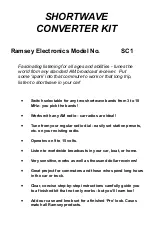
12
REV UP/DOWN
Control
Synopsis
The diesel engine may have its engine revved up or down at any throttle stop including
zero. Activating
(rev up/rev down) activates manual rev mode. A transition to
speed step zero resets manual throttle control back to automatic throttle control. Under
automatic throttle control the Rev Levels change up as the throttle is increased and
down as the throttle is decreased. The rev level only changes after the ramp up/ramp
down sound is finished and a throttle change is made. Motor power is also monitored
and the rev levels will change depending on overall load on the locomotive.
Manual
Manual mode may be activated at any throttle stop. Pressing
engine to rev up one level per press.
Example:
Power engine and start (
). Press
three times. Notice the rev level
changes to rev level three. Increase the throttle stop to one.
Pressing
causes the diesel to rev down one level per press.
Example:
After following the above example, press
changes to rev level two. Set the throttle stop to zero. The diesel now
automatically revs down to idle. Automatic mode is now engaged.
Automatic
Once the throttle stop is greater than zero, automatic mode is activated. Make sure that
is not active. Throttle up from zero to one. The locomotive will rev up to
bit1 is zero (default) motor loading is enabled. The
locomotive rev levels now are controlled by two criteria; throttle changes and
locomotive loading.
Grid Blower Effects
Once the locomotive is notched up and moving, activating the grid blower motor
(
) automatically slowly notches the locomotive down, eventually to idle. A throttle
increase while the grid blower is active turns off the grid blower and throttle control is
returned. Setting the throttle to zero disables the grid blower.













































